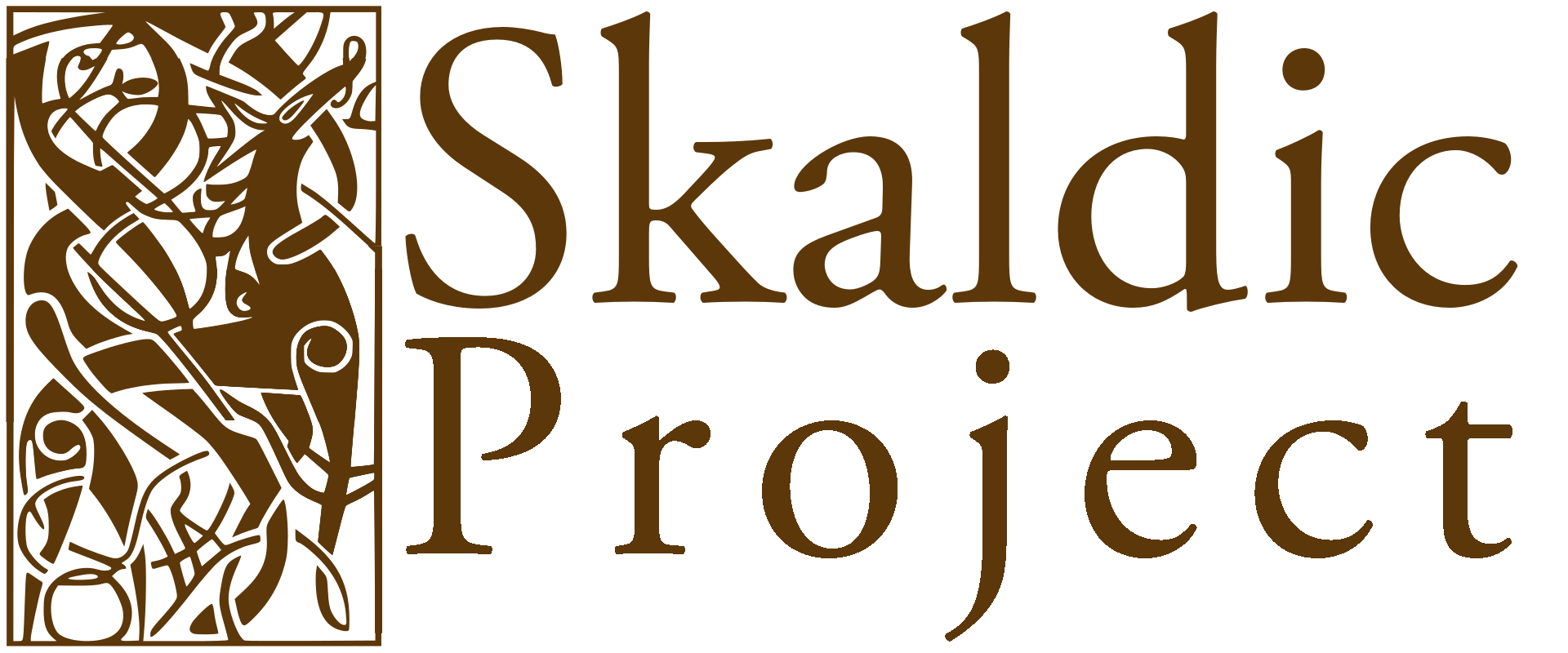Mark Eirdr 7II
Jayne Carroll (ed.) 2009, ‘Markús Skeggjason, Eiríksdrápa 7’ in Kari Ellen Gade (ed.), Poetry from the Kings’ Sagas 2: From c. 1035 to c. 1300. Skaldic Poetry of the Scandinavian Middle Ages 2. Turnhout: Brepols, p. 439.
Hróðigr átti brynþings beiðir
bjartan auð ok frœknligt hjarta
minni gnógt ok manvit annat
mest; fylgðu því hvergi lestir.
Alla hafði ǫðlingr snilli;
ungr nam hann á margar tungur;
Eirekr vas, sás mátti meira,
mestr ofrhugi, jǫfri flestum.
{Hróðigr beiðir {brynþings}} átti bjartan auð ok frœknligt hjarta, gnógt minni ok mest annat manvit; lestir fylgðu hvergi því. Ǫðlingr hafði alla snilli; ungr nam hann á margar tungur; Eirekr, sás mátti meira flestum jǫfri, vas mestr ofrhugi.
{The famed convenor {of the byrnie-meeting}} [BATTLE > WARRIOR] had bright wealth and a brave heart, abundant memory and other common sense to the highest degree; flaws did not accompany that. The ruler had absolute eloquence; when young he learned many languages; Eiríkr, who could do more than most princes, was the most courageous.
Mss: JÓ(146), 873ˣ(49r), 20b I(7r), 180b(29v) (Knýtl)
Readings: [1] brynþings: byrðings 180b [2] frœknligt: ‘frøklikt’ 20b I, ‘freglikt’ 180b [3] gnógt: ‘nogt’ 20b I [4] fylgðu: so 20b I, 180b, fylgði JÓ, 873ˣ [6] á: om. 20b I, 180b
Editions: Skj AI, 446, Skj BI, 415, Skald I, 205; JÓ 1741, 146-7, ÍF 35, 217 (ch. 73).
Context: Eiríkr’s personal qualities of intelligence, courage and eloquence.
Notes: [All]: According to Saxo (2005, II, 12, 3, 2-3, pp. 66-9), Eiríkr had a superior intellect, he was very eloquent and an excellent speaker at assemblies. Saxo also emphasises his great stature and physical strength. — [1] brynþings ‘of the byrnie-meeting’: 180b offers the alternative reading byrðings (m. gen. sg.) ‘of the ship’, giving the kenning beiðir byrðings ‘bidder/demander of the ship’, i.e. ‘seafarer’ (cf. Anon Pl 38/7VII). — [6] ungr nam hann á margar tungur ‘when young he learned many languages’: Lit. ‘he learned in many languages’. According to Knýtl (ÍF 35, 219), Eiríkr did not need an interpreter when he travelled abroad. For the ‘foreign language requirement’ in ON literature, see Kalinke 1983.
References
- Bibliography
- Skald = Kock, Ernst Albin, ed. 1946-50. Den norsk-isländska skaldediktningen. 2 vols. Lund: Gleerup.
- ÍF 35 = Danakonunga sǫgur. Ed. Bjarni Guðnason. 1982.
- JÓ 1741 = Jón Ólafsson, ed. 1741. Æfi dana-konunga eda Knytlinga saga: Historia Cnutidarum regum Daniæ. Copenhagen: [n. p.].
- Kalinke, Marianne E. 1983. ‘The Foreign Language Requirement in Medieval Icelandic Romance’. MLR 78, 850-61.
- Internal references
- (forthcoming), ‘ Unattributed, Knýtlinga saga’ in Kari Ellen Gade (ed.), Poetry from the Kings’ Sagas 2: From c. 1035 to c. 1300. Skaldic Poetry of the Scandinavian Middle Ages 2. Turnhout: Brepols, p. . <https://skaldic.org/m.php?p=text&i=19> (accessed 27 April 2024)
- Jonna Louis-Jensen and Tarrin Wills (eds) 2007, ‘Anonymous Poems, Plácitusdrápa 38’ in Margaret Clunies Ross (ed.), Poetry on Christian Subjects. Skaldic Poetry of the Scandinavian Middle Ages 7. Turnhout: Brepols, pp. 204-5.
Stanza/chapter/text segment
Use the buttons at the top of the page to navigate between stanzas in a poem.
Information tab
- text: if the stanza has been published, the edited text of the stanza and translation are here; if it hasn't been published an old edition (usually Skj) is given for reference
- sources: a list of the manuscripts or inscriptions containing this stanza, with page and line references and links (eye button) to images where available, and transcription where available
- readings: a list of variant manuscript readings of words in the main text
- editions and texts: a list of editions of the stanza with links to the bibliography; and a list of prose works in which the stanza occurs, allowing you to navigate within the prose context
- notes and context: notes not linked to individual words are given here, along with the account of the prose context for the stanza, where relevant
Interactive tab
The text and translation are given here, with buttons to toggle whether the text is shown in the verse order or prose word order. Clicking on indiviudal words gives dictionary links, variant readings, kennings and notes, where relevant.
Full text tab
This is the text of the edition in a similar format to how the edition appears in the printed volumes.
Chapter/text segment
This view is also used for chapters and other text segments. Not all the headings shown are relevant to such sections.
